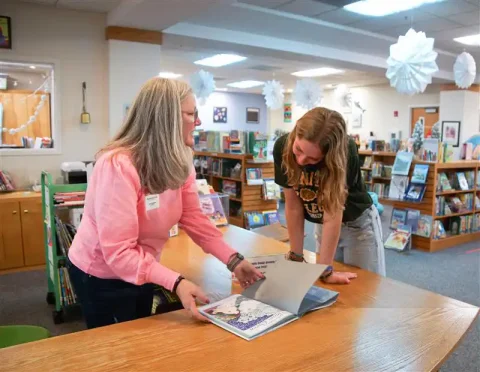If you haven’t already, be sure to listen to the excellent season two bonus episode of Ask Mike. In the episode, titled “How Do I Create a Podcast?” Mike Taylor, CJE, and guest Samantha Jo Berry of Bridgeland High School in Houston, Texas, discuss the many benefits of adding podcasts to her journalism class curriculum. Whether the podcast stands alone or works as a supplement to a yearbook spread, students pick up valuable skills like listening, interview skills and multimedia journalism.
Taylor and Berry focus on the “why” of podcasting and teaching students to create podcasts, but they also delve into the “how.” To make it easy for educators considering adding podcasts to the curriculum – maybe a yearbook adviser whose staff has finished the book and needs a way to fill the time – we’ve combined tips from their interview and our experience getting the Walsworth Yearbooks Podcast Network (WYPN) off the ground.
1. Know what you want to do with your podcast.
What’s the purpose of your podcast? Education, entertainment, storytelling? When we planned the launch of WYPN, we knew we wanted Ask Mike to be educational, with a focus on yearbook skill-building, while we wanted Yearbook Chat with Jim to be a podcasts that shares peoples’ yearbook stories. Having one focus doesn’t mean your podcast can’t be multipurpose. There’s definitely educational value to Yearbook Chat with Jim, and Ask Mike would be boring without the entertainment value he throws in! When we added Behind the Byline to the WYPN mix, we knew we wanted to showcase the ways people use scholastic journalism in their post-graduation careers, so storytelling with a dash of education.
What audience do you want to target? Do you want to make a podcast that your school’s students will listen to? Do you want to target the larger community? Do you want to create a must-listen for other yearbook staffs? Keep your target audience in mind as you plan your podcast. This will play a large part in shaping the product.
2. Get set up.
What equipment will you need? It’s easy to fall down the rabbit hole of fancy microphones and pricey headphones, but there’s no need for it. You can make a podcast with just your smartphone. Taylor travels the country working face to face with yearbook staffs, so he can’t be burdened with a lot of extra equipment for Ask Mike. Many of his interviews are recorded using an app on his phone!
The Recording Program
Berry’s students use QuickTime to record on their smartphones. I have the Voice Record app on my iPhone. Anchor is an everything-included podcast recording app with high reviews.
Because many of Jordan’s interviews for Yearbook Chat with Jim are done remotely, he uses the Zencastr program for its convenience and high sound quality. The basic level is free to use, but paid upgrades are available. It’s a great time to be a podcaster. Conference call apps like Zoom can be used to record remote interviews, and Skype recently rolled out the ability to record calls in-app. Gamers may be familiar with Discord, which can also be used to remotely record high-quality interviews for free!
For in-person interviews, the free Audacity program is a great option for both recording and editing audio. There’s a bit of a learning curve, but it’s a very valuable skill to learn and you can find hundreds of training videos online.
The Microphone
If you have some extra money in your budget, a decent external microphone is a good investment. We like the Audio-Technica ATR2500 and the Blue Snowball. Both are “plug and play” microphones, meaning you use the USB drive on your computer. The Blue Yeti is also a USB mic, and very popular among podcasters. However, don’t feel pressured to buy a microphone. The microphone in your smartphone is great! So long as you control for outside factors, only audiophiles will be able to tell it was done on a phone. (I’ll let you in on a secret: I used to work in radio and often used my iPhone to record interviews instead of the station-provided professional equipment. I was never once called out on it.)
Headphones and Speakers
You’ll need a way to listen back to your podcasts. When it comes to headphones, whatever you’re already using to listen to music is good enough for podcasting. If you’re going to spend a lot of time listening through your headphones, over-ear versions are better for your auditory health and comfort. It’s fine if they have wireless capabilities or a built-in microphone, but it’s useful if you have the option to turn those off. I use a pair I bought off Amazon and they fit all my needs. If all you have is a pair of earbuds, those will work just fine! I can’t stress this enough: Podcasting does not need to be expensive.
The Recording Space
Where you record depends on what kind of sound you’re going for. If you want ambient noise to set the scene, record the interview on-site but use caution. Too much background noise can obscure the interview subject’s voice and make them difficult to understand. But if you’re doing a piece about the homecoming parade and you can hear the marching band in the background, it helps your listeners feel like they’re really there. This can also be faked with a little bit of editing, which we cover below.
Berry shared a tip to help her students get better sound when recording in public: they plug their microphone-enabled headphones into their phone and have the interview subject hold the microphone near their mouth (just not too close). This helps cut down on background noise. If you know you won’t need to hear the host, like if you’ll pull quotes for a piece, you can have the interviewee hold the phone about six inches away from their mouth.
If there’s no compelling reason to record in an area with background noise, find a quiet place like an empty classroom. This will help ensure everyone can be clearly understood. So long as you hold the microphone in a good place (typically 6-12 inches from your mouth), you’ll sound great and won’t need to worry about ambient noise from ventilation systems or what’s happening on the other side of the closed door.
3. Plan ahead.
What format will your podcast take? Berry teaches her students to use interview, topical and narrative formats.
WYPN uses the interview format for our podcasts. Our regular hosts choose a topic and guest or guests who fit the podcast mission. For Ask Mike, if Taylor is talking with someone and thinks, “Hey! This would make a great podcast episode!” he’ll often pull out his recording equipment and hold the interview right there. For Yearbook Chat with Jim, Jordan reaches out to friends and friends-of-friends who have a great yearbook story to tell. Because Behind the Byline is still fairly new, the interview subjects tend to be people we know personally, but we’re planning to expand our pool of subjects now that the podcast is established. Interview-style podcasts use a question-and-answer format, but don’t feel like it’s a rigid format. Keep it conversational, but focused on the interview subject.
Berry describes topical podcasts as a conversation. Think of a sports podcast where a group of people discuss the game. These are some of the easiest podcasts to produce.
Narrative podcasts take planning, but are great for building skills. RadioLab and This American Life fall into the narrative category. Highly produced investigative journalism podcasts take enormous amounts of work and planning, but the payoff is huge. The current top podcast on iTunes is The Dropout, an in-depth seven-part investigative series on Elizabeth Holmes and the Theranos medical company fraud scandal. Serial is also in the current top ten, in its third season, and remains one of the most popular podcasts of all time.
Podcasts that tell fictional stories are also popular, and offer a way for young writers to flex some writing muscles that wouldn’t normally be used. Welcome to Night Vale has been running since 2012, and the popularity of podcasts like Homecoming has attracted the attention of television networks. Audio storytelling is different than written storytelling, so have some fun exploring the possibilities!
Do your research. Terry Gross, of Fresh Air, is known for her insightful interviews. She prides herself on the research she puts in before sitting down at the microphone. If she’s interviewing an author, she reads their book. If she’s interviewing an actor, she watches their movies. Be like Terry Gross. Scroll through your interview subject’s Instagram feed. Read their blog. Google their name. Know everything you can before the interview.
Practice and listen back. Don’t mumble, mouth breathe or smack your lips. Everyone hates listening to themselves (at least at first), but it’s the best way to break yourself of bad habits. Practice recording a few times before the interview or main recording session. Listen back. You probably aren’t aware of some of your bad habits. But don’t be too hard on yourself. As Berry tells her students, “Nobody hates the sound of your voice as much as you do.” You are your own worst critic, so make it constructive criticism!
4. Recording.
Research is good, but planned questions are bad (sort of). If you need to take down some talking points ahead of time, that’s ok, but be flexible. If you go in with a set list of questions, looking for quotes, the interview will sound unnatural and you could miss out. If your subject casually mentions the pet skunk they had as a kid, but you have a list of questions and are focused on moving on to asking about their college plans, you’ve missed the opportunity for a great story!
Listening is important. This is one of the most valuable skills to be learned and honed through podcasting. Like any skill, it takes practice. You’ll get better the more you do it. Curiosity is a valuable trait, and you’ll probably become a more curious person in tandem with improving your interview and listening skills.
Be humble. Focus on the people in the room with you. If it’s an interview, focus all your energy on your subject. Don’t worry about asking the questions that make you sound smart. Ask the questions that will draw out great stories. If it’s an uncomfortable subject, key in to their responses and body language. You’ll learn when you need to push on or draw back. If you’re part of a panel, don’t always assume you have the best thing to say. Give your cohosts the chance to talk and listen so you’ll be ready to respond to them.
Be a little extra. You want to be yourself on the podcast, but be a slightly exaggerated version of yourself. Turn up the dial just a smidge for a more engaging final product.
5. Editing.
Be ruthless. When I’m editing a WYPN podcast, any time I catch myself starting to zone out means I probably need to cut that segment. The golden rule for podcast length is often said to be about 45 minutes, but I believe an episode should be as long as it needs to be. However, it just so happens that 45 minutes seems to be the perfect amount of time to include all the best parts of an hour-long interview. It can be painful to cut – it can feel like you’re mutilating your baby – but the audience won’t know what they’re missing. And if you leave in audio that isn’t absolutely riveting, they’re not going to listen to the end.
Have some fun. If you are able to edit your recordings, you can throw in some intro music. As your skills increase, you’ll be able to soundscape the podcast. These are great to listen to, but take a lot of hours to create. There are hundreds, if not thousands, of videos online you can use to learn the necessary skills. As you get better, you’ll be able to fake the ambience we mentioned above. If you did an interview about the homecoming parade in a quiet room, you can attend the parade itself and record the marching band as it goes by. You can then lay the sound of the marching band under your interview to add to your podcast!
The free, open-source audio editing program Audacity is a favorite among podcasters. If you can afford it, Adobe Audition is great but not a necessity.
If you don’t have the ability to edit your podcast, don’t fret! Just make sure you’re really focused while recording. Listen and respond appropriately. Don’t let the conversation get overly sidetracked or off-topic, although not all tangents are bad. They can be fun, as well as revealing new and unexpected information about the interview subject.
6. Publish.
Once your podcast is ready, it’s time to publish! You’ll need somewhere to host your podcast. WYPN uses Libsyn. Podbean is a popular choice, as is Soundcloud. These sites can host and distribute your podcast to listening platforms like iTunes and Spotify. Some apps and playing sites require approval – notably, Apple’s podcast platforms – so allow for plenty of time when you release your first episode.
Don’t be shy. You want people to listen, so promote! Let people know you have a podcast on social media, school announcements or in the school newspaper. This is where having a set target audience will really benefit you. If your audience is parents of students at your school, find their Facebook group. If you’re targeting graduating seniors, hang fliers near the senior lockers.
Be open to feedback. Listen to what people are saying and read the comments. Take suggestions under consideration, but don’t give any credence if people decide to be mean. Just like anywhere on the internet, sometimes anonymity draws out the ugliness in people. They also tend to be especially critical of women and girls’ voices – so much so that This American Life did a segment on it. When that happens, brush it off and block them if you can.
The best way to grow your audience is to continually publish great content. Let people know it’s there, but creating something they want to listen to will ensure they come back for future episodes and tell their friends about it.
If you have any questions about starting your own podcast, feel free to reach out to me at podcasts@walsworth.com. I also recommend listening to podcasts. Every example cited above is a good choice. There are some great yearbook podcasts available now. Of course, we recommend the three WYPN podcasts. The Yearbook Whys by journalism educator Mike Simons is also a good listen.
Ultimately, just remember these three important podcasting truths:
- You’ll get better with practice.
- It doesn’t need to cost money.
- You are your own worst critic.
Whether you’re starting your own podcast or getting your students started, good luck with your podcast journey and welcome to the club!





